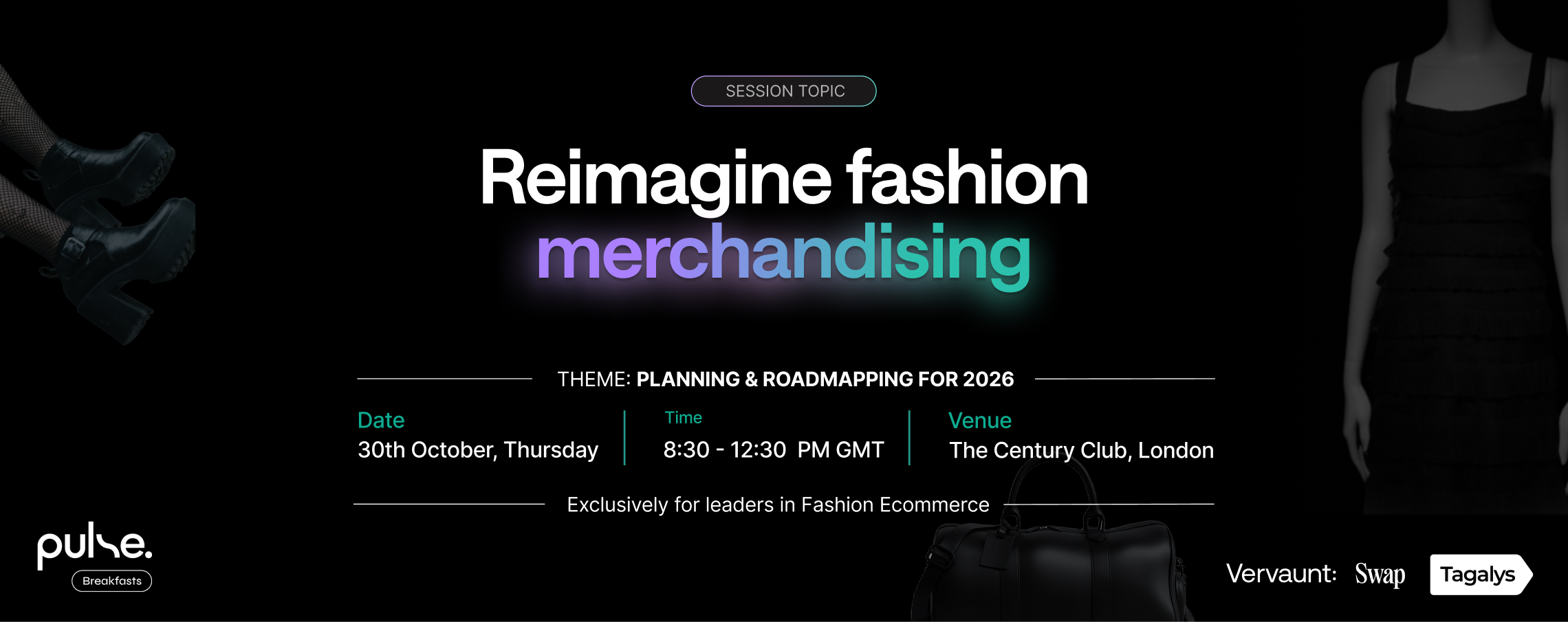“Chase the vision, not the money; the money will end up following you.”
– Tony Hsieh, CEO, Zappos
Back in 1989, when Compumarket was introduced by Sequoia Data Corp as the first internet-based eCommerce, no one in the world knew how vital eCommerce would become in the years to come. Today in 2020, especially in the aftermath of COVID-19, eCommerce has seen a boom worldwide. Do you know that by 2040, 95% of purchases are predicted to be made online?
When the future is all about eCommerce dominance, how do you make sure that you don’t get lost in the digital clutter and succeed despite the competition? The vision is important for any eCommerce store to succeed, literally and figuratively. While your vision about the growth of your eCommerce store is something you need to work on, on your own, there are a few things you can do about how your eCommerce store looks to your customers. One of the most important things to do is get your eCommerce merchandising strategy right because visitors are more likely to buy what they see. eCommerce merchandising ensures that they see, what they like.
Imagine this. You spend thousands of dollars for your eCommerce store’s digital marketing campaign, but when potential customers land on your page, they do not convert! This is because they cannot find what they are looking for, find it hard to navigate; the store loads slowly, or is simply not interesting or engaging enough. This leads to lost revenue and higher acquisition costs. But there is a fix to increase sales! eCommerce merchandising!
eCommerce merchandising will help you create an influential first impression in your potential customer’s mind. Why are we so sure that it works? Because eCommerce giants around the globe are already doing it! Let’s learn some valuable lessons from them!
What is eCommerce Merchandising?
It is the art and science of displaying and arranging products on an eCommerce store strategically with the ultimate goal of increasing revenue and business growth. eCommerce merchandising helps to maximize revenue by increasing product views that lead to higher add-to-carts, which then lead to purchases.
eCommerce merchandising enhances the visual appeal of your eCommerce store and improves its overall appearance. It is also a great tool to make the customer experience better.
An underrated star, merchandising plays a significant role in how visitor shops. It also contributes to brand perception. eCommerce merchandising reduces product discovery time, which is crucial, especially since retailers have very little time to convert visitors on mobile devices. In the era of digital marketing, it is tough for eCommerce retailers to compete as everyone is fighting for consumer attention by way of social media campaigns.
Before we learn from the eCommerce giants we have a quick, pro tip for you. It might not be manually possible to take care of every merchandising feature for your eCommerce store. But what if we told you we could give you superhuman product merchandising powers?
With Tagalys’s visual merchandising solutions you can improve your CTR upwards of 35% with ease! You can get product performance insights to merchandise your product listing pages, tap into data to know what’s working to promote and demote products, do advanced product sequencing, set smart category conditions, and global sort options among many other things! Curious already? Head to Tagalys.
Lessons to learn from the top eCommerce giants
1. Amazon
Creating & displaying ‘Featured Categories’

A great online merchandising lesson is to create product listing pages in sync with your marketing and merchandising strategies, along with what’s trending at that point in time. You can sequence your products according to the season or create any other product listings to make them featured. Tagalys can help you achieve this in a few minutes!
Use of attractive banners:

Amazon aces it when it comes to banner display. What is unique to Amazon for online merchandising is not just the display of banners on the top of the home page but also in the middle. These banners stand out among the display of products and collections and a great way to make the user click on the CTA.
Display of daily deals:

The use of the daily deals feature conveys the message that the deal is time-bound, and the customer must act now and grab that product at discounted prices. This is a great online merchandising strategy.
2. Target
Focus on ‘Discounts’:

Customers love discounts, and Target plays well on this factor by displaying the percentage of discount offered in bold and right at the top. You, too, can sequence discounted products at the beginning of the home page using Tagalys!
Creating & displaying ‘Featured Categories’

Some categories might outperform others. Featuring categories on your landing page can increase the click-through-ratio. Customers can also easily find the products they are looking for. Tagalys allows you to identify trending categories and products using the T-score to help your customers find what they want.
Highlighting USPs:

What are the other USPs of buying from your eCommerce website, except for the product collection? Target sets an example by highlighting where it matters.
3. Macy’s
Visually appealing product photography:

The most important driving factor for a potential customer to click on a product is the product photographs. Macy’s has aced this and done visual merchandising at its best.
Dedicated deals page:

Don’t make your customers hunt for deals and coupon codes. Do what Macy’s has done! Make it easily accessible and list all the details, segregated by the department on one page. Happy customers are returning customers!
Product Recommendations:

When a customer clicks on a product, offering product recommendations similar to the product they are looking at is one of the eCommerce best practices. This will also help in increasing the average order value.
4. Walmart
Displaying ‘Ratings’ in thumbnails:

Walmart takes the thumbnail game one-step ahead by displaying the ratings right below the product name. Reviews and ratings play an important role in helping a customer make a purchase decision while shopping online.
Product Recommendations:

When a person scrolls down after seeing a product, Walmart shows similar products that were bought by the customers who also bought that product. It is highly likely that the person looking at these recommendations may add one or more of the products to the cart, increasing the average order value. With Tagalys, you can do this in a matter of zeptoseconds, figuratively speaking.
Default product sorting by ‘Bestsellers’ or ‘Trending’:

Walmart’s default product sorting is by “bestsellers” in that category. This is a smart move as “bestsellers” are those products that are liked and wanted by the customers. They are going to perform well. When the customers see what they like, they don’t bounce off the store and potentially, convert.
Secondly, in each category, Walmart has “new arrivals” and “best sellers”, linking to those curated categories. This makes it easy for a customer to directly navigate and browse through the products that are doing well on your eCommerce store. Most online retailers get their traffic from these two categories.

5. Zappos
Quick Filter and Sort options:

Zappos makes it really easy to filter and sort the product listings so that the customer can find what they need without bouncing off. It is literally one-click-easy.
Curated & customized Collections or Categories:

Zappos has created interesting collections for their customers to shop from. These attract customer attention and increase CTR. With Tagalys, you can customize your product collections intuitively using a merchandising panel.
Product Sequencing:

When you click on any category on Zappos.com, the first few product listings will be of various types, showcasing product diversity. Instead of displaying the same type of product in a broad category, Zappos keeps a customer hooked with variety.
6. Home Depot
Organized filters & sort options:

Home Depot has conveniently placed varied filters and sort options on the left of the product listing page. It is convenient to use for potential customers and makes it really easier for them to find the products. The eCommerce store allows filtering by keywords, style, certifications, and listing, etc. These filter options are unique and related to Home Depot and are different from what is seen in other stores.
Perfect search bar placement and size:

Home Depot nails how a search bar should be placed on an eCommerce store. It is big and placed well in the center. This serves as a call to action to visitors who land on the eCommerce store. Visual merchandising done right!
7. ASOS
Advanced product sequencing:

ASOS, one of the top eCommerce retailers, has aced product sequencing by displaying a different type of products in each row, allowing for higher product diversity and discoverability. This also ensures that a visitor does not get bored by seeing the same kind of product repeatedly, ultimately dropping off of the eCommerce store. For example, in the image below, we can see different types of shoes in the first few rows themselves.
This is also an effective way of ensuring that potential customers with different choices can each find what they need, and this would help increase sales. Get in touch with Tagalys to learn how sequencing can be done within seconds.
Smart filter options:

Every leading eCommerce store has filters and sort options, stressing its importance for product discovery. In the case of ASOS’s the filter and sort, options are so curated that make the visitor’s job easier. The default sort option says, “Our favorite,” which is just a unique name for “Trending.” By giving importance to sorting products by what’s trending, ASOS is maximizing add-to-cart actions.
8. Zalando
Curated offer recommendations:

Before a potential customer starts browsing the products, Zalando offers something called “curated offer recommendations.” These recommendations appear to be hand-picked to someone who is browsing through your eCommerce store and attracts attention.
This way, you can also promote a certain handpicked set of products that can potentially resonate with visitor interests. With Tagalys, you can create such curated Product Recommendations.
Displaying product sizes & colors in thumbnails:

Zalando has been thoughtful when it comes to the use of thumbnails, which is why this is an important merchandising lesson. Most of the time, when a user likes a product and clicks on it, only then the user see what size that product is available in. After clicking on a product, when a user doesn’t find the desired size, it leads to disappointment.
When this happens multiple times, a potential customer may give up and delay shopping on your eCommerce store. The same logic applies to the selection of colors. To make it easy for users, Zalando displays the colors and the product sizes in the thumbnails, making it a breeze for customers to be informed and shop.
Use of ribbon overlays:

Zalando uses signage or ribbon overlays to highlight the unique aspects of a product in the listing itself. For example, in the image above, you can see how products have signages like “sustainability,” “new” to attract the visitor’s attention. The ribbon overlays also highlight the percentage of discounts on discounted products. You can consider this eCommerce merchandising lesson in mind while creating product listings for your store. Using Tagalys, you can promote and sequence products on your eCommerce store and start engaging the visitors to the maximum.
Tagalys maximizes conversion rate & gives merchants visual control of products displayed in Site Search & Product listing pages at their online store. There’s also a lot more you can do with Tagalys as a Marketer. Sounds exciting and you would like to learn more? Book a Free Demo today with us today.
References:
- https://kinsta.com/blog/ecommerce-statistics/
- https://en.wikipedia.org/wiki/E-commerce#:~:text=1989%3A%20In%20May%201989%2C%20Sequoia,WorldWideWeb%2C%20using%20a%20NeXT%20computer.
- https://www.amazon.com
- https://www.target.com/
- https://www.macys.com/
- https://www.freepik.com/free-vector/add-cart-concept-illustration_7140741.htm#page=1&query=online%20shopping&position=2














.svg)
.svg)
.svg)
.svg)
.svg)
.svg)



.png)

.png)
